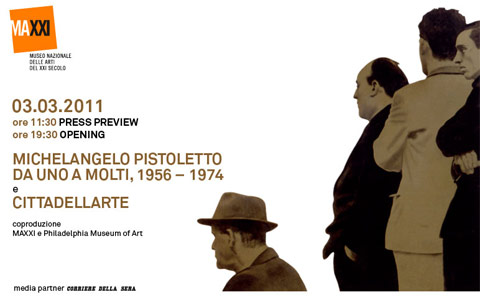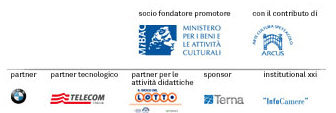Michelangelo Pistoletto: Da Uno a Molti, 1956-1974 curated by Carlos Basualdo MAXXI (Museo nazionale delle arti del XXI secolo), Rome (Italy) | from March 4th to August 15th 2011

curated by Carlos Basualdo
at MAXXI (Museo nazionale delle arti del XXI secolo), Rome (Italy) | from March 4th to September 11th 2011
Michelangelo Pistoletto: Da Uno a Molti, 1956-1974 will present the work of one of the most influential living European artists, one of the founders of Arte Povera in the 1960s and a forerunner to contemporary participatory practices that have dominated the field since the mid-1990s.
In Rome at MAXXi the exhibition co-produced by the PHILADELPHIA MUSEUM OF ART (curated by Carlos Basualdo, The Keith L. and Katherine Sachs Curator of Contemporary Art, where Michelangelo Pistoletto: From One to Many, 1956-1974 has been on show from November 2nd 2010 to January 16th 2011. further information about the exhibition in Philadelphia
The exhibition will place Pistoletto’s oeuvre in the context of the socio-cultural transformations of Italy and Western Europe in the post-war period as well as relate his work to the most important developments in American art since the 1960s—Pop Art, Minimalism and Conceptual Art.
Most importantly, it will emphasize the participatory aspect of his work that has structured his practice from the mid-1960s on.
Drawing from both American and European public and private collections, the presentation will include over 100 works of art, many of which have never been exhibited before in the United States. Pistoletto began exploring the tension between the individual human figure and the anonymous spectator at the beginning of his career.
After first portraying himself in his paintings, he then sought to include the spectator through the progressive use of increasingly reflective surfaces. In the "Quadri specchianti" ("Mirror Paintings"), which he created by gluing hand-painted figures onto mirroring surfaces of stainless steel, the artist incorporated the viewer’s reflected image into the work as a fundamental part of its experience.
By concentrating on the passage from the first self-portraits of the mid-1950s to the collaborative actions of the late 1960s and early 1970s, the audience will follow Pistoletto’s journey from a rigorous investigation of self-representation to the development of the creative collaborations that have since characterized his artistic practice.
The exhibition will also include sections devoted to Pistoletto’s "Plexiglass" works from 1964 that clearly prefigure Conceptualism, his Stracci (Rags) sculptures from the late-1960s and early-1970s that exemplify his Arte Povera period, and documentation of the performance work that he produced with his Zoo group from 1968 to 1970.
An extensive selection of "Mirror Paintings" from 1962 to 1974 will allow visitors to trace the evolution of the artist’s technique while mapping the sociopolitical changes in Italy during that period, which are clearly identifiable in Pistoletto’s progressive choice of subject matter.
A centerpiece of the show will be Pistoletto’s "Oggetti in meno" ("Minus Objects"), a group of sculptural objects created in 1965 and1966 in which the aesthetics of seriality and non-compositionality of Minimalism are purposefully contested by emphasizing the discrepancies between each individual work and by drawing inspiration from fields as diverse as artisanship, architecture, design, and popular culture.
As is the case for Pistoletto’s entire oeuvre, the connecting factor in the "Minus Objects" is never a predetermined artistic project or plan, but rather a reliance on improvisation, the artist’s deep knowledge and love of materials, and a passionate emphasis on singularity and difference rather than repetition and homogeny. The installation design of the exhibition will place all of these bodies of work in close dialogue with each other. Pistoletto’s "Mirror Paintings" will be distributed chronologically and will punctuate other series such as the Minus Objects and the Rags to elucidate Pistoletto’s clear artistic evolution and the impact of the cultural and political milieu in his practice.
Cittadellarte
Pistoletto’s current project, Cittadellarte—whose name implies both a fortified enclave and city of art—will be represented in conjunction with Michelangelo Pistoletto: Da Uno a Molti, 1956-1974 in the dedicated Cittadellarte exhibition.
Therefore, Cittadellarte will highlight the intellectual, political, and social dialogues fostered by Cittadellarte through an exhibition and associated program of activities that utilize the exhibition space as a social and educative forum.
The exhibition Cittadellarte has been produced with the support of Fondazione Cassa di Risparmio di Biella, Fondazione Zegna and Lauretana.
www.fondazionemaxxi.it
Michelangelo Pistoletto


